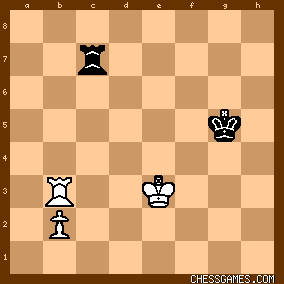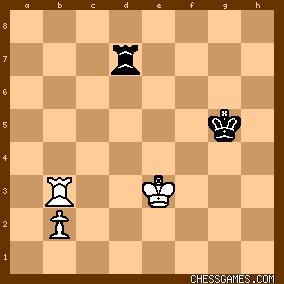|
< Earlier Kibitzing · PAGE 3 OF 3 ·
Later Kibitzing> |
| Oct-16-07 | | MostlyAverageJoe: <ahmadov: <QuidProQuo: I like this puzzle, because although it is quite easy for my human brain it is almost insolvable with for an engine.> That is not quite correct IMO... Also, it depends what engine you are speaking about.> Well, until shown otherwise, I tend to agree with <QuidProQuo> and expect that most engines would go for the losing 80. ... Rxg5 move, as it reduces the material imbalance and the resulting checkmate (about 100 plies away) is far beyond their horizon. I will try running Fritz/Crafty/Rybka/Fruit/Zappa for perhaps an hour each to see what they do ... Engine with help of tablebases MIGHT be able to find the draw. But 6-piece tablebases require an investment of about a terabyte of disk storage. This said, I definitely see that the position might be solvable with a specialized algorithm. The number of possible positions of the remaining pieces is not that large and the upper bound is easily estimated: disregarding the pawns, two king and two rooks could be arranged in 61*61*61*61 positions (not all of them legal, but never mind; this is just an estimate). The black pawn can occupy 7 positions (4 of them after taking the black R on a2/c2), the g/h pawns can stay or advance for the total of 8 combinations, the white b pawn can occupy 7 positions in the b-file and another 12 in a/c files (this would involve taking the black R). In each position it may be white's/black's turn to move. So, the upper bound is: 61*61*61*61*7*8*(7+12)*2 = 29,463,949,648 positions or so, give or take an order of magnitude (I did not account for different ways of promoting the pawns once they reach the last rank, but then I did not discard illegal positions). Definitely searchable with enough hardware, although probably not with an average home computer :-) |
|
| Oct-16-07 | | kevin86: I recall a similar problem a few years ago by the kamikazi rook. Black must,of course avoid white freeing himself with a capture by pawn (at c3) or rook on the f-file. |
|
| Oct-16-07 | | jackpawn: If you have seen the concept before it's a very simple puzzle. |
|
| Oct-16-07 | | nuwanda: i don't think that 80...Rc7 also saves the draw for black. The position after 81.Rf8 Kxh7 82.Rb8 looks like a clear win for white to me... |
|
| Oct-16-07 | | twin phoenix: ok i been thinking about it alot and am wondering did white blow a win? seems like he had a decisive advantage but i can't figure out how to cash it in. i can't come up with any plan that wins for white. by 76. k-e3 the position seems drawn. perhaps even earlier at 48. Rxh4. thought this was a bad play but what else does white try? there isn't any way to make progress with out going in for this line of play. where's the winning line??!! |
|
| Oct-16-07 | | whiteshark: Klaus was West German Chess Champion 1976. He also played at the chess olympiad 1976 in Haifa, scoring 4.5/6.
So maybe at the height of his creative power. |
|
| Oct-16-07 | | whiteshark: A <crazy rook> is called <Desperado-Turm> in German. Is 'desperado rook' also a known term in English ? |
|
| Oct-16-07 | | CapablancaFan: Just when white thought he had the win in sight, Andersson weasels his way out of the loss with the famous kamikaze rook tactic. White does not want to capture the rook due to instant stalemate(draw),but when it becomes clear he can't escape the rook's harrasment he just gives up. I'll say this though, the ending was a little luck on Andersson's part more than any skill he might have displayed. Credit to him for finding the tactic. |
|
| Oct-16-07 | | patzer2: For today's puzzle solution, Andersson forces a draw with the stalemate decoy offer 80...Re5+ =. Since White's King cannot escape the constant Rook checks without a three-fold repetition of position or a stalemate, the game is drawn. |
|
| Oct-16-07 | | Shams: <Is 'desperado rook' also a known term in English ?> indeed it is. the word is American in origin (from Spanish, obviously)-- meaning a violent bandit of the old west. :) |
|
Oct-16-07
 | | HeMateMe: Can black also draw with R-c2, draw with his own queening threats? |
|
| Oct-16-07 | | MostlyAverageJoe: <nuwanda: i don't think that 80...Rc7 also saves the draw for black.
The position after 81.Rf8 Kxh7 82.Rb8 looks like a clear win for white to me> I think you're right (and I was wrong with the 81.g6 Re7+ idea). For example: 80. ... Rc7 81. Rf8+ Kxh7 82. Rb8 Kg6 83. Rxb3 Kxg5
results in: 
click for larger viewbut it is still a while to go. White has two winning moves (Rb6 and Kd4) mating in 38 and 47 moves respectively. Curiously, if the black rook was just one square to the side: 
click for larger view
the position would be drawn (if played by computers or super GMs :-). |
|
| Oct-16-07 | | PAWNTOEFOUR: i found Re5+ easily enough,but at the time i did i didn't know what was in store.........nice tactic......no wonder andersson's so hard to beat |
|
| Oct-16-07 | | whiteshark: Thanks, <Shams>, such rooks are indeed s.th. you should fear for... |
|
| Oct-16-07 | | popski: Haha, this ending is funny! |
|
Oct-16-07
 | | fm avari viraf: It's seems to me that white just played mechanically without giving a second thought that Black could snatch his vital half point with the stalemate technique. To-day, also I keep myself aloft from the elite band of solvers since I keep teaching such stalemate theme & techniques in my "Avari Chess Academy." |
|
| Oct-16-07 | | nuwanda: hi <maj>, looking at tablebases you're right, but i think in your line 83.Kf4 is, for humans, a much more natural move, and then its a clear win for white, no matter if the black rook is on c7 or d7. Of course black can win the white pawn at g5, but the white king is active then and the black one is stranded at g5. Though the win will take some moves, its relatively elemantary. |
|
| Oct-16-07 | | pawnofdoom: Intersting game. I'm surprised I got this. There was no way black could win. So that means black had to draw! Maybe the puzzle could haev started one move earlier. To see if someone would choose 79. ... ♔h8 over ♔xh7, which I think is the wrong move |
|
| Oct-16-07 | | Fezzik: FM Avari,
You may want to teach the difference between "stalemate", draw by repetition, and 50 moves without progress. (Note, there is no official "perpetual check" category in the FIDE rule book!) This game allows for all three draws, depending on how White plays! |
|
| Oct-16-07 | | whiteshark: Here is another <crazy rook> game, theme starts around move 60: E Post vs Nimzowitsch, 1905 |
|
| Oct-16-07 | | unferth: <mpmeints: Again a question-move 79 why doesn't black take the pawn at H7. White can take back (rook to F7 as he does)with check, but he now can move to G6 abd pressure the rook and capture another pawn and gain a material lead.
What am I missing?>
79 ... Kxh7 80 Rxf7+ Kg6 81 Rb7 Kxg6 82 Rxb3 is lost for black, I think. |
|
| Oct-16-07 | | YouRang: <HeMateMe: Can black also draw with R-c2, draw with his own queening threats?> I don't think so. After 80...Rc2, white has 81. Rf2!, which protects the b-pawn and removes the stalemate vulnerability. Black cannot play 81...Rxf2 or allow 81. Rxc2 as the exchange of rooks win for white. Therefore, black must move his rook away, giving white a chance to play 82. g6 and get his rook behind his passed pawns, winning. (Or if black tries to prevent 82. g6 with 81...Rc6, then white still wins with 82. Rf6). |
|
| Oct-17-07 | | Madman99X: Surely white wins with precise play. 79. Kf4 with the idea of bringing the king to the 8th rank comes to mind. |
|
| May-27-09 | | WhiteRook48: just play 83 Kd3 and get over to the b-pawn |
|
| May-28-14 | | Howard: Oh, jeez ! Another long, stubborn endgame that seems to defy analysis ! Just came across it when looking (once again) at that famous endgame from 1975 where the recently-deceased Sax "won" a game because his Soviet opponent resigned in a drawn R+P vs R ending. |
|
 |
 |
|
< Earlier Kibitzing · PAGE 3 OF 3 ·
Later Kibitzing> |





































